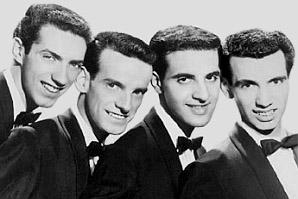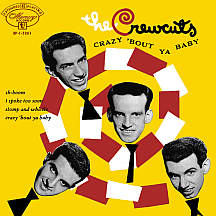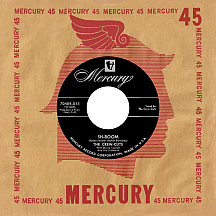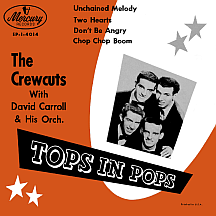THE CREW-CUTS
Catholic choir school: be there or be square! That was the case, at least, in Toronto, Ontario at the midpoint of the 1950s. Being in the limited-member all-boy chorus at St. Michael's Choir School was the main goal for students lucky enough to be admitted, though with rock and roll music breaking big in the States, a handful of quietly rebellious students spent their spare time following the progress of rhythm and blues vocal groups in what seemed like faraway places several hundred miles southeast of the Canadian border in cities like New York and Philadelphia. Fate decreed that two groups with unusual names (Otnorots and Canadaires) would become top-selling stars throughout North America and other parts of the world (after adopting somewhat more accessible names). The Crew-Cuts were one of those ambitious acts. There was just one discrepancy: none of them wore their hair crewcut-style!
In the late 1940s, four friends were nearing graduation from St. Michael's. Rudy Magueri and John Perkins had been in the Otnorots (backwards that's torontO) with Bernard Toorish and Corrado Codarini (nickname: "Connie"), often emulating the barbershop style of vocal harmony. Once released from the choir's strict procedure, Bernie and Connie formed a new act with Jimmy Arnold and Frank Busseri; as The Four Lads, they signed with Columbia Records and enjoyed a string of hits from 1951 to 1959. Baritone Rudi (who sang lead on most of the group's ballads) and tenor John (who sang lead on uptempo numbers) figured they had what it took to follow the Four Lads' lead; they recruited tenor Pat Barrett and filled out the foursome with John's younger brother Ray Perkins, who sang bass.
As the Canadaires, they appeared mostly in Toronto clubs througout 1952; later, their manager secured them a stint at McVan's Niteclub, a three hour drive over the border to Niagara Street in Buffalo, New York. Their style evolved as more doo wop ballads were introduced into the repertoire. A road trip to New York resulted in a spot on the popular TV show Arthur Godfrey's Talent Scouts, followed by the quartet's first and only single release as the Canadaires, "Chip Chip" ('...sing a song, little sparrow...'), for a small New Jersey label, Thrillwood. Nothing happened with it and the guys headed back to Toronto; even though they were all well over 18 years of age, their parents (the Perkins, mainly) insisted that if something didn't happen soon, they would have to give up their show business dreams and get regular jobs. Not surprisingly, the four singers didn't care much for the idea.
The Gene Carroll Show, an extremely popular TV series on Cleveland, Ohio's channel 5, WEWS, hired the group for a full week of performances as guests. "Crazy 'bout Ya Baby," a catchy original song written by Magueri and Barrett, caused a sensation with local viewers and they were invited back for a second week, mainly due to requests to see them perform it again. WERE 1300 AM afternoon deejay Bill Randle, one of America's most powerful radio personalites of the time, noticed what was going on and reached out to his connections at various record labels. Randle figured "Canadaires" was a real tongue-twister (or could he have felt there was no need to announce to every listener this was a north-of-the-border group?). Someone came up with the bright idea their music was the opposite of "longhair" (a mid-century slang term for classical symphonies) and suggested a new name: the Crew-Cuts (not necessarily a compliment). Never mind that they didn't wear their hair quite that short. They did, however, release an album, Crew Cuts Go Long Hair, combining classical melodies with uptempo band arrangements and slang-filled lyrics.
But would a new moniker make any difference? Several labels large and small passed on the act. Then they got a chance to audition for Mercury Records of Chicago. Producer/A&R man Art Talmadge liked the song enough to offer them a very limited one-disc deal. Putting them into the studio with arranger David Carroll, "Angela Mia (My Angel)" was recorded as the A side at Art's insistence, but he let the quartet pick the B side...so of course they chose "Crazy 'bout Ya Baby" ('...want you all to myself!'). Visiting many radio stations on a promotional tour, they encouraged the DJs to play the B side (against Talmadge's wishes). It didn't take much convincing to get them to play the uptempo "Crazy" and it took off, reaching the top ten in July '54.
Mercury offered them an extended contract and they got down to serious hit-making business in the studio. "Sh-Boom" by Bronx quintet The Chords was already breaking at R&B and pop and as much as the boys would have preferred to continue releasing original material, Mercury wasted little time in having them lay down a cover of the infectious 'life could be a dream' tune. Copies were pressed and sent to stations within days and the record flew past the Chords' version (which nevertheless made a strong showing in the top ten of the pop charts while not quite topping R&B). The Crew-Cuts' sanitized take (with all those 'ya-da-da-da-da-da-da-da-da-da's) moved quickly to number one, where it stayed for most of August and September.
While their leading competitors the Four Lads and Philly-based quartet The Four Aces generally avoided performing original songs by black performers, the Crew-Cuts went along with the cover version trend. Their follow-up, "Oop Shoop," an R&B hit by Shirley Gunter and the Queens, provided writer and singer Gunter with a royalty windfall. Songs of this type kept the Crew-Cuts riding high on the charts for more than two years. One detour from the pattern was a pair of children's singles: "The Barking Dog" and a Christmas/winter effort, "Dance Mr. Snowman Dance."
But the massive success of "Sh-Boom" had pigeonholed them into an ongoing routine of covering the latest R&B hits...not exactly what the foursome had envisioned for themselves 'way back in choir school. They reached the top ten in 1955 with versions of "Ko Ko Mo" (Perry Como also had a major hit with his cover of the Gene and Eunice hit) and "Earth Angel" (giving The Penguins a run for their money). Other songs they successfully covered that year were Nappy Brown's "Don't Be Angry," The Danderliers' "Chop Chop Boom," The Nutmegs' "A Story Untold" and another top ten, "Gum Drop," first done by Otis Williams' group The Charms. Meanwhile, misspellings of their name on various releases started to occur, alternating the hyphenated spelling with Crew Cuts and Crewcuts, an anomaly that continued for years.

A late '55 single made a successful departure from the pattern. "Angels in the Sky," a spiritual tune, was backed by "Mostly Martha" from German composer Friedrich Von Flotow's Martha opera with added lyrics, each side a top 40 hit. The group's final hit single came in early 1957 with rocker Ric Carty's "Young Love," which placed their cover at the back end of a three-way race against number one charting versions by Sonny James and Tab Hunter. Their recording made a "passable" top 30 showing.
The Diamonds, who'd been with Mercury a few years, achieved a coup in 1957 with their million-selling cover of The Gladiolas' "Little Darlin'," essentially making them the label's priority group just as the Crew-Cuts' fortunes were on the wane. They left Mercury in 1958 and signed with RCA Victor, following Hugo Peretti and Luigi Creatore, who'd produced a few tracks for them at Mercury but were on the verge of doing greater things with the new company. Finally granted artistic freedom sans covers, the Crew-Cuts relished working in that capacity with Hugo and Luigi. But there was only one minor chart single during their time at RCA: "Hey, Stella! (Who Zat Down Your Cellar?)," a rapid-tempo rock and roll novelty unlike anything they'd done before.
Leaving RCA in 1960, they landed on several labels over the next five years, trying different approaches: a remake of Johnnie and Joe's "Over the Mountain" on the Warwick label, "Twistin' All Around the World" on Whale Records during the peak of the '62 "twist" dance craze, in addition to alternating ballads, rockers and novelty discs on ABC-Paramount, Vee-Jay and Chess. They split up in 1964 but occasionally reunited to make records and perform live. In 1984, The Crew-Cuts were inducted into the Canadian Academy of Recording Arts and Sciences' Music Hall of Fame; the event was attended by both The Four Lads and The Diamonds and all three acts performed their greatest hits.
NOTABLE SINGLES:
- Chip Chip - 1953
as the Canadaires - Crazy 'bout Ya Baby /
Angela Mia (My Angel) - 1954 - Sh-Boom - 1954
- Oop-Shoop - 1954
- The Barking Dog - 1954
- Dance Mr. Snowman Dance - 1954
- Ko Ko Mo (I Love You So) /
Earth Angel - 1955 - Don't Be Angry /
Chop Chop Boom - 1955 - Two Hearts - 1955
- A Story Untold - 1955
- Gum Drop - 1955
- Are You Havin' Any Fun - 1955
as the Crew Cuts - Angels in the Sky - 1955 /
as the Crew Cuts - Mostly Martha - 1955
as the Crew Cuts - Seven Days - 1956
as the Crew Cuts - Tell Me Why - 1956
as the Crew Cuts - Young Love - 1957
as the Crew Cuts - Susie-Q - 1957
- Hey, Stella! (Who Zat Down Your Cellar?) - 1958
as the Crew Cuts - Baby Be Mine - 1958
- Over the Mountain - 1960
as the Crew Cuts - Twistin' All Around the World - 1962
- Hip-Huggers - 1963
as the Crew Cuts - The Three Bells - 1963
as the Crew Cuts - You've Been In - 1969
as the Crew Cuts




